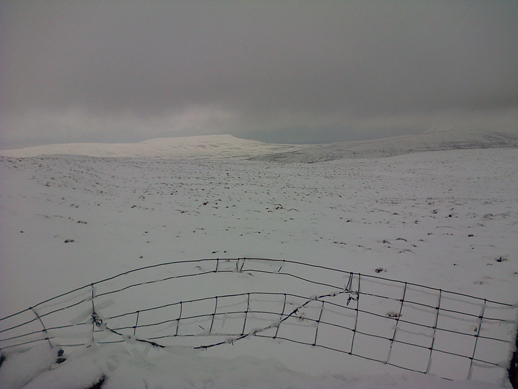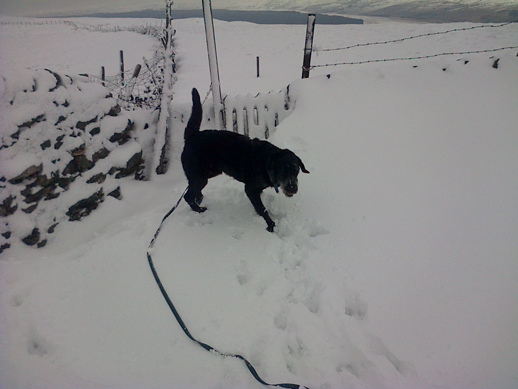Words by Lisa Samson.
All I see is stone and sky and snow. There are no trees here and the moor land grasses are buried. Pen-y-ghent rises like a giant tortoise swimming in foamy sea, dominating this silent landscape. The track, marked by an absence of grass tufts, curves downhill into Langsthrothdale and there are snow drifts piled against the dry stone wall that stretches east to west. We are standing on the Horse Head, a moor land ridge that is remote in any weather, debating whether to turn back or continue the walk we’ve planned.
The sun was out when we left the brown valley of Littondale and we had no idea of the snowy wasteland that awaited us. We followed the steep Horse Head Pass signposted to Yockenthwaite, pausing to admire clusters of fresh snowdrops sheltering against a farm wall. Plants come into bud about a week later than in our lowland town an hour south of here. The track wound widely round the hillside, revealing a sweep of hill and forest with each bend, like climbing a helter skelter into a white whirl of snow. We saw sharp pronged stalactites poised above the jagged gash of a frozen waterfall, black against the snow, where water trickled beneath the ice.
There is no wind and the only sound is of the dog panting. He plunges into the fresh snow, twisting and rolling joyfully. His delight is infectious and, since he is happy to test the depth of the snow before we step in it, we follow him. It reminds me of the snow racket walking I did many years ago in the Alps, only this time I have no rackets to control the depth each foot falls. Cautious at first, I use the single walking stick we have brought with us to check for rocks.
We spoil the smooth surface of the snow, bringing muck up from underneath with our deep tread, scattering a trail of dirty droplets. The dog leaves a yellow zigzag of piss, marking out this untouched territory for his own. Progress is slow because you have to sink each foot in turn, pulling against the suck of buried moisture. It is exhilarating stepping where no one else has walked before and it makes me giddy like a child.
Ahead of us on the other side of the wall is a stone cenotaph they call the trig, so I speed up to reach it first, attempting a slow run like a moon man. I ignore Mike’s warning to take care, and rush ahead before tripping on a hidden stone. The view is long ranging but a fine mist hangs over the moor and I can just make out Ingleborough, a brooding dinosaur residing over its lofty terrain.
My trousers are soon sodden and my ears are stinging. After a while, it dawns on me that this isn’t a good idea, but going back would mean giving up. Even the dog is plodding now. Other than a few sheep at the start of the walk, we’ve seen no living thing: no birds or animals or people. We check the map every so often and argue over which way to go. It is hard to navigate in a featureless landscape. We are looking for a pile of stones marked on the map but the snow has carpeted all rocks and furrows and only the top of the wall protrudes, slicing across the iced moor land. We climb over a gate in the wall wedged by snow drifts and, reassured by an arrow, we strike out downhill. The arrow is not complemented by a place name. We don’t have a compass and, even if we did, neither of us knows how to use one properly.
The wall we are trailing along goes on and on into the horizon and it seems that we have been walking for hours. Four hours to be precise. Every direction is the same: snow stretching to a pale sky. There is hardly anything to differentiate the two. We’re getting anxious and I charge off in a direction I think is right, even though I can’t identify any landmarks. Mike refuses to follow me and the dog whines for his master, sitting stubbornly in the snow. Our angry voices are lost in the emptiness of sky and field. Eventually, Mike matches some woodland across the valley to a patch on the map and says we need to retrace our steps and follow the wall to a stile.
After slogging uphill we find a well maintained gate that swings open easily, despite the drifts. We stand a while to decide which direction is the right one, when suddenly, a vision appears out of the snow: a woman with red curly hair is walking towards us. I stare, unsure whether I am imagining her. Mike has also noticed her so I assume she is real and I stride forward to meet her, ready to throw my arms round her. She is walking with a partner and they are well equipped, with one stick each rather than one between two. Sensing our desperation, they suggest we follow their footprints across the moor back to Halton Gill, which is where we began our walk. I tell them not to follow our footprints or they’ll be walking in circles all night long.
I’ve always admired people who can use a compass and it is only thanks to the skill of our incidental guides that we make it back home. They said they had never been on these moors before, so it seemed to us a minor miracle that they had managed to navigate their way across the white wasteland. We follow their footprints for a few miles over troughs and gullies, over rocks and stiles and through streams and puddles, until we find ourselves descending the hillside into Halton Gill once more. Sheep are grazing peacefully in the evening sun and smoke curls from chimneys. The tiny hamlet of Halton Gill seems like the centre of civilisation and an inflatable dinosaur tied outside a house waves in the breeze.
Photos by Mike Hitchins.

